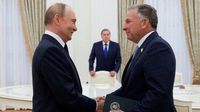Ukrainian President Volodymyr Zelensky is set to arrive in Washington on August 18, 2025, for a high-stakes diplomatic summit with U.S. President Donald Trump—a meeting that could reshape the trajectory of the war in Ukraine and reverberate across the global stage. According to Axios, as reported by JinSe Finance, the agenda is packed: U.S. military and financial aid, regional security in Eastern Europe, and the broader geopolitical strategies that have come to define the conflict are all on the table.
This summit comes at a particularly tense moment. Behind the scenes, the United States and Russia have reportedly discussed a controversial new model for ending the war in Ukraine, one that mirrors Israel’s decades-long occupation of the West Bank. According to The Times, this idea was floated in recent weeks during conversations between Steve Witkoff, Trump’s peace envoy, and his Russian counterparts. The proposal would see Russia exert military and economic control over occupied Ukrainian territories through its own governing body, while Ukraine’s borders would technically remain unchanged—much as the West Bank is still considered Palestinian territory under international law, even as it remains under Israeli control.
One source close to the U.S. national security council explained the plan: “It’ll just be like Israel occupies the West Bank. With a governor, with an economic situation that goes into Russia, not Ukraine. But it’ll still be Ukraine, because … Ukraine will never give up its sovereignty. But the reality is it’ll be occupied territory and the model is Palestine.”
Yet the White House has pushed back hard on these reports. Anna Kelly, deputy White House press secretary, dismissed the story outright, saying, “This is total fake news and sloppy reporting by The Times, who clearly has terrible sources. Nothing of the sort was discussed with anyone at any point.”
Regardless of the veracity of the occupation model proposal, the fact that such ideas are circulating underscores the immense diplomatic and strategic pressures facing both Ukraine and the United States. For President Zelensky, the summit in Washington represents an opportunity to shore up international backing and secure continued U.S. support—militarily, financially, and politically. He is expected to emphasize Ukraine’s ongoing reforms and its commitment to democratic values, aiming to reinforce his country’s standing on the global stage.
President Trump, meanwhile, faces his own set of challenges and opportunities. The Washington meeting offers him a chance to reassert U.S. leadership in international diplomacy and reaffirm alliances with key partners in Eastern Europe. It’s also a platform to articulate clear foreign policy goals and demonstrate support for democratic institutions—something that will be closely watched both at home and abroad. As Axios noted, the outcomes of this summit will be scrutinized by domestic and international audiences alike, highlighting the high stakes involved.
At the heart of the discussions lies the question of U.S. military and financial aid to Ukraine. The continuation and potential expansion of support for Ukrainian defense capabilities will be a top priority, especially as the war approaches its fourth year and Russia’s military presence remains entrenched in parts of eastern Ukraine. Economic cooperation and U.S. investment in Ukraine are also expected to feature prominently, with both leaders likely to explore ways to bolster Ukraine’s economy and encourage reforms that could pave the way for greater stability and prosperity.
Energy security and anti-corruption efforts are additional focal points. For Ukraine, reducing dependence on Russian energy and tackling corruption are essential steps toward long-term sovereignty and integration with Western institutions. For the U.S., supporting these initiatives aligns with broader goals of promoting regional stability and countering external threats.
But the specter of the occupation model looms large. The controversial plan—patterned after Israel’s occupation of the West Bank—would allow Russia to maintain de facto control over occupied Ukrainian territories without formally redrawing borders. This approach is seen by some U.S. negotiators as a pragmatic (if deeply problematic) way to acknowledge the realities on the ground and the reluctance of other nations to become directly involved in the fighting. “We live in the real world. The Trump administration lives in the real world,” said Sebastian Gorka, Trump’s senior director for counterterrorism, during a May interview with Politico. “We recognise the reality on the ground. Number one, that’s the beginning because we’re not utopianists and we’re not human engineers. We’re not some kind of pie in the sky believers in utopia. We recognise the reality on the ground and we have one priority above all else, whether it’s the Middle East or whether it’s Ukraine. It’s to stop the bloodshed. Everything else comes after the bloodshed has been halted.”
Yet the analogy to the Israeli occupation is fraught with controversy. The International Court of Justice has ruled Israel’s occupation of the West Bank illegal, a decision not recognized by the United States and only partially accepted by Russia. In March 2022, the court ordered Russia to “immediately suspend military operations” in Ukraine, a binding order that Russia has ignored—much as Israel has ignored repeated UN resolutions calling for withdrawal from the West Bank. The international community remains deeply divided, with the United Nations General Assembly most recently voting 124 to 14 to demand an end to Israel’s occupation, a resolution opposed by Israel and the U.S., with Britain abstaining.
For many in Ukraine and beyond, the prospect of an occupation model is deeply unsettling. President Zelensky has consistently refused to cede Ukrainian territory and remains committed to defending the country’s sovereignty. However, with the war grinding on and direct international intervention off the table, some see the occupation model as a possible mechanism to achieve a truce—if only to halt the bloodshed after three and a half years of conflict.
The upcoming Washington summit, then, is about more than bilateral ties or even the immediate future of Ukraine. It’s about the broader question of how the international community responds to protracted conflicts, the limits of diplomacy, and the realities of power in a world where ideals often collide with hard geopolitical facts. As the world watches, the decisions made—and the ideas debated—at this meeting could have far-reaching consequences for global security and diplomatic engagement.
With so much at stake, the ability of Presidents Zelensky and Trump to find common ground and outline actionable next steps will be crucial. Whether the summit leads to new forms of cooperation, a reimagining of the conflict’s endgame, or simply a reaffirmation of existing positions, it will mark a pivotal moment in the ongoing struggle for Ukraine’s future and the international order at large.
As events unfold in Washington, the world waits to see whether diplomacy can deliver meaningful progress—or whether the realities on the ground will once again dictate the terms of peace and conflict.

